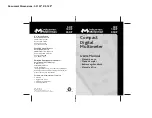
7 Prospective
short circuit
current (PSC)
tests
21
WARNING
Never connect this instrument across two phases. Never attempt
to measure the phase to phase prospective short circuit current.
7.1 What is Prospective Short Circuit Current?
The Prospective Short Circuit or Fault Current at any point within an
electrical installation is the current that would flow in the circuit if no
circuit protection operated and a complete (very low impedance) short
circuit occurred. The value of this fault current is determined by the supply
voltage and the impedance of the path taken by the fault current.
Measurement of Prospective Short Circuit Current (PSC) can be used to
check that protective devices within the system will operate within safety
limits and in accordance with the safe design of the installation.
7.2 Testing Prospective Short Circuit Current
PSC is normally measured at the distribution board between the phase and
neutral, or at a socket outlet between phase and earth.
If testing at a distribution board proceed as follows:-
1
Select the 200A, 2000A or 20kA range.
2
Connect the distribution board lead to the IEC socket on
the instrument.
3
Connect the red phase probe of the lead to the phase of the
system, the black probe to the neutral of the system and the
green crocodile clip to the neutral of the system.
4
Ensure that the two green P-E and P-N LEDs are on and the third
red LED is OFF.
5
Press the test button. A test will start at the sound of a bleep.
6
Wait for the display to clear to zero before conducting another
test or disconnecting the instrument. It is good practice to
disconnect the phase lead first.
Note:
For loop impedances greater than 50
Ω
(PSC less than 5A
approx) it is not possible to obtain an accurate PSC reading and
the unit will lock out the PSC range by displaying the ‘OL’ over-
range symbol.
If the PSC ranges are selected whilst connected to a socket
outlet via the mains lead, a test will take place between Phase
and Earth due to fixed wiring of the moulded mains plug i.e. a
Phase-Earth fault current
test.








































